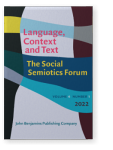Vol. 4:1 (2022) ► pp.61–83
Some linguistic features of the physical sciences research article before, during and after the First World War
Previous studies suggest that in times of great turbulence scientific writing becomes more conservative. In order to see whether this is true of the period of the First World War, a sample of research articles in the field of the physical sciences for the years 1900, 1910, 1920 and 1930 was studied. Features relating to process types, passives, first person pronouns, themes and nominalisation were considered. This showed that while there was little evidence for the initial conjecture, it was frequently the case that the direction of change altered during the period 1910 to 1920. This change was often maintained in the following decade. Thus, there are significant changes occurring in the period 1910 to 1920 which warrant further study.
Article outline
- 1.Introduction and background
- 2.Process types
- 3.Passive voice
- 4.First person pronoun subjects
- 5.Themes
- 6.Nominalised processes
- 7.Discussion and final thoughts
- Notes
-
References
